Cooler, longer-lasting and more wavelength-specific than incandescent bulbs, far-red LEDs will be the green future of horticulture.
Maximizing food resources in large-scale operations may be the best way to bring sustenance to those without, but doing so does not come cheaply. There is increasing interest around the world not only in boosting food production, but also in controlling the associated costs.
One way that horticulturists look at the problem is to try to take control of plant biology. Tweaking the photosynthesis mechanisms of plants or refining the way in which they use various wavelengths of light delivered at different times of the day are two such methods. And LED-based lighting gives scientists a good shot at controlling these factors and more.
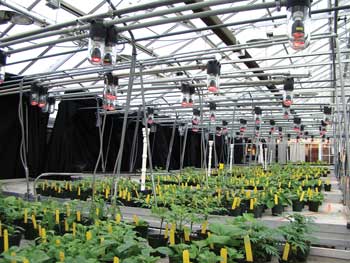
Researchers at Michigan State University are testing the ability of LED systems to promote plant growth inside greenhouses. Courtesy of Erik S. Runkle.
Sunlight is the standard for growing crops, of course. It’s been around forever and isn’t going away anytime soon. However, sunlight contains every visible wavelength known – and many outside that range. The amount of available sunlight varies with season, climate and weather as well, making it one of the least controllable factors in agriculture.
Bringing plants indoors and shining the light from incandescent lamps is common, but not really that much better. You get the yellow, red and far-red wavelengths that plants desire for good growth, but you also get a lot of thermal energy, which translates into heat that must be exhausted from a greenhouse or other growing chambers, or from indoor plant factories.
“Growers are always interested in reducing their input costs,” said Erik S. Runkle, associate professor of horticulture and a floriculture extension specialist at Michigan State University in East Lansing. “One of the ways this can be accomplished is by reducing electrical consumption. Potential benefactors of our research include growers of flowering plants (for low-intensity lighting applications) and young plant and vegetable crop growers (for high-intensity lighting applications).”
Low-intensity applications include crops that require long photoperiods, or blocks of daylight. High-intensity applications include plants that thrive best when their photosynthetic processes are boosted over short time spans.
The light-intensity range required for boosting plant growth depends upon the location, time of year, crop, temperature and CO2 content in the air surrounding the plants, Runkle said. Given those vagaries, the common light intensities used to increase photosynthesis range from 50 to 200 µmol/m2/s – or approximately 4100 to 16,400 lx from high-pressure sodium lamps. Horticulturists measure intensity in molar units rather than lux because the latter is defined by how light is perceived by human vision.
“Growers of day-length-sensitive crops (many bedding plants and herbaceous perennials) can benefit from low-intensity photoperiod lighting,” Runkle said. “People who grow plants in completely enclosed environments can also benefit from LED lighting, such as a tissue-culture facility.”
“Greenhouse production of flowers, potted plants and vegetables has clear advantages over field production, where crops are exposed to the vagaries of weather and other environmental conditions,” said A.J. Both, associate extension specialist at Rutgers University in New Brunswick, N.J. Because modern greenhouses require significant initial and on-going investment and consume a lot of energy, he added, it is important to use any resource as efficiently as possible.
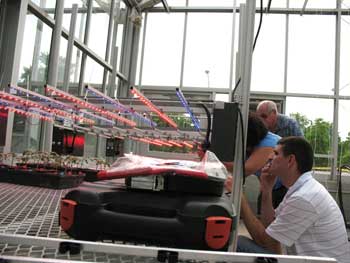
C. Michael Bourget of Orbitec and Celina Gómez and Cary Mitchell of Purdue University adjust the red-to-blue ratio and total photon flux on an overhead LED array that minimizes shading of solar irradiance throughout the day in the greenhouse. Courtesy of Robert C. Morrow, Orbitec.
“LEDs offer the potential to reduce electricity consumption, while maintaining or even improving plant growth and development,” he said.
Supplementing Sol
Plants contain phytochromes – proteins that react to light in the way that the rods and cones in eyes do. Phytochromes may preferentially react to various wavelengths, and the proportion of proteins that react to red and far-red wavelengths in any given plant type helps determine how much supplemental lighting will affect the plant. A consortium of research institutions, including Rutgers, has, for example, reported that more far-red than red tends to help most plants grow faster, while more red than far-red can suppress growth.
Horticultural LED investigators also have noted that far-red light is particularly useful to plant growth and development, with 735 nm being the sweet spot for many crop plants. Far-red light particularly helps the development of plant stems, including the hypocotyls that mark the early stage of seedling development. It also enhances later leaf production and overall growth rates. Improving the developmental speed of hypocotyls helps especially with grafting operations, including increasing speed and enhancing the general health of hybrids.
Supplementing the amount of light that plants receive at the end of the day can positively affect stem growth, which generally happens at night for many plant types. Adding far-red LED light for a short period after daylight helps promote stem, hypocotyl and leaf growth during the night following.
LEDs can be made to emit highly specific wavelengths; e.g., keeping plants happy with a continuous 735-nm bath. Unfortunately, the availability of far-red LEDs is very low.
At the University of Arizona in Tucson, for example, Chieri Kubota and her colleagues found that greenhouse-grown leaf lettuce experienced more than 25 percent improvement in growth when exposed to far-red light for 3.3 minutes at the end of each growing day at an intensity of 46 µmol/m2/s.
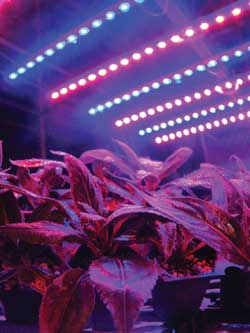
Cuttings of herbaceous New Guinea impatiens are propagated under red and blue supplemental lighting from LEDs, shortly after sunset at Purdue University. Reprinted from Chronica Horticulturae, Vol. 52, No. 1 (2012). Courtesy of International Society for Horticultural Science.
Whereas the sun has a well-defined trace across the sky, LED devices could be placed in the most optimal spots. Unlike with incandescent lamps, proximity of LEDs to leaves and stems does not cause burning or dehydration of plants. However, LED placement is still not well determined, and there may yet be a distance that defines “too close.” Studies are ongoing at Arizona, Michigan State, Rutgers and other institutions to find out where the truth lies.
Another open question is whether adding motion to the light source might aid growth conditions indoors. Passing a bank of LED emitters over an array of young plants seems in some cases to enhance hypocotyl growth and to inhibit it in others.
“The main goal is to provide the light where it is most needed,” Both said. “As plants grow and develop, their size and configuration change. As a result, it may be more efficient to deliver the light at different locations of what we call the crop canopy.”
Whether moving light sources over the canopy or even between rows is practical or economically feasible remains to be determined. Both said that stationary LED sources likely will turn out to be preferential.
More challenges
Dousing greenhouse crops in specific far-red or other wavelengths may be great for the plants themselves, but not so much for the people tending to them. Low-intensity far-red light may not lead to accidents, but it certainly would color workers’ perceptions of plant health come inspection time.
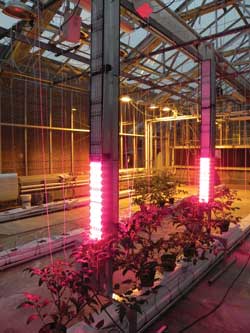
Young tomato plants receive supplemental lighting from LED towers. While the plants are small, only the lower portion of the LED array must be lit, thus saving electricity. Reprinted from Chronica Horticulturae, Vol. 52, No. 1 (2012). Courtesy of International Society for Horticultural Science.
“Based on the absorption of light by plants, they are most efficient in converting blue and red light in the process called photosynthesis,” Both said. “But under blue and red light, plants look very different when observed by the human eye. Therefore, additional colors may need to be added to improve human perception during the production process.”
Many companies advertise LED systems for plant lighting, but few systems have been tested extensively in commercial applications, Both said. In addition, claims about spectral output, intensity, lamp life, lamp decay, efficiency and other aspects have been difficult to verify.
“The LED research consortium we started under the leadership of Dr. Cary Mitchell of Purdue University is attempting to develop some standards and measurement procedures that the greenhouse industry can use to determine what systems are most appropriate for their specific applications,” Both said.
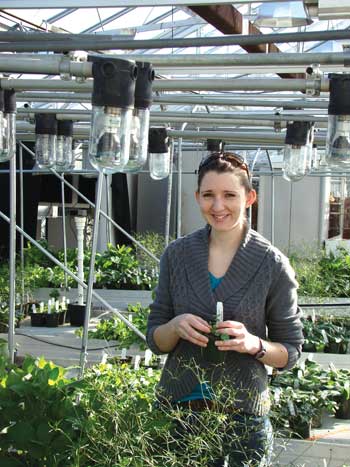
Master’s student Daedre Craig of Michigan State works with several plant species that receive various ratios of red and far-red wavelengths from overhead LEDs during night-interruption studies of floral induction and development. Courtesy of Erik S. Runkle.
The consortium thus far has worked with Orbital Technologies Corp. of Madison, Wis., and the Regensburg, Germany-based Osram Opto Semiconductors AG to develop LED systems in a range of wavelengths.
Because LEDs are a relatively new technology for plant-lighting purposes, Both said, much research is still needed to determine their best use and application.
“It is very likely that the best use of LEDs differs from crop to crop and even during the different life stages of a particular crop,” he said. “Artificial light has been used for plant growth applications for over a hundred years, and we are still discovering novel aspects as we learn more about plant physiology, light sources, control strategies, etcetera.”
It likely will take some time before researchers sufficiently understand the advantages and challenges associated with LEDs used for plant lighting, Both said, adding that rapid developments in LED technology continue to present new obstacles to research and applications.
The use of LEDs for plant lighting is just getting started, and there are many questions left unanswered about this application, Both said.
“Our research hopes to contribute to our collective understanding of plant lighting and the benefits and challenges of LED lighting,” he added.
Advantages of LEDs in Greenhouses
• Lower heat output, permitting proximity to plants
• Highly selectable wavelengths
• Lower cost of use
• Longer life than incandescent lighting
• Compact device size
• Flexible design options for horizontal or vertical lighting and for moving fixtures
• Potentially higher quantum efficiency
LED Research Consortium
Michigan State University
Orbital Technologies Corp. (Orbitec)
Purdue University
Rutgers University
University of Arizona
LEDs That Fit Agriculture – on Earth and Beyond
Orbital Technologies Corp. (Orbitec) of Madison, Wis., is a key supplier of lighting systems for the greenhouse LED consortium based out of Michigan State University. Working with terrestrial systems, however, was not the company’s starting point. The following is an interview with the company’s bioproducts and bioproduction systems head, Robert C. Morrow:
What is Orbitec’s purpose in making LED lighting systems?
Morrow: We began making LED systems as part of our work developing plant research systems for space, and we began to expand that into traditional agricultural and research applications. In addition to LED systems, Orbitec develops aerospace life-support-system technologies and propulsion-related technologies.
Who is your typical customer, and how do you impress them with the benefits of LED lighting systems?
Morrow: Most of our LED systems are currently developed as custom systems to support university and government research. These customers generally are interested in the ability to individually control multiple spectral bands independently, and the ability to provide high photon flux levels. Much of our work has resulted from collaborative projects or word of mouth. We work with the customer to understand their requirements, determine what is feasible, and then design and fabricate the system.
What cooling systems do you recommend for LED lighting systems in greenhouse environments? Does this differ between celestial and space-based systems?
Morrow: We primarily use forced convection (fans) for both our terrestrial and flight systems. For very high output arrays, we use a chilled water cooling system.
Is there an advantage to moving the LED light sources across the plant canopy?
Morrow: For some agricultural applications, this can reduce hardware costs. We make custom systems that do this and are working on future products that would use this technique.